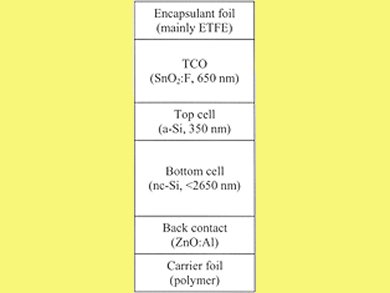The market share of thin-film solar cells is increasing. Several thin-film solar cell types have been the subject of environmental life cycle assessment (LCA). However, no LCA has been presented yet of a variety of environmental impacts of a flexible solar cell laminate with thin-film tandem solar cells composed of a top layer of amorphous silicon (a-Si) and a bottom layer of nanocrystalline silicon (nc-Si).
N. J. Mohr, Radboud University Nijmegen, The Netherlands, and colleagues present a LCA for this type of thin-film solar cell incorporated in a laminate, as developed by the Dutch company Helianthos. The schematic structure of the encapsulated a-Si/nc-Si solar cell is pictured.
The cells are considered to have 10 % conversion efficiency, their expected service life is 20 years. The production scale considered is 100 MWp/a.
The construction for roof integration, the silicon deposition, and etching are found to be the largest contributors to the primary energy demand of the a-Si/nc-Si PV system, whereas encapsulation and the construction for roof integration are the largest contributors to its impact on climate change.
- Environmental life cycle assessment of roof-integrated flexible amorphous silicon/nanocrystalline silicon solar cell laminate,
N. J. Mohr, A. Meijer, M. A. J. Huijbregts L. Reijnders,
Prog. Photovolt: Res. Appl. 2012.
DOI: 10.1002/pip.2157



